URL optimization is a small but crucial step in optimizing your website. This process will ensure Google and other search engines have no trouble crawling and interpreting the page’s content and figuring out the website’s structure.
URLs also need to be short and readable so that users understand (or at least get a very good idea of) what they will see when they click on a URL, whether that’s a URL shared on social media or a URL on a SERP.
This article will walk you through the entire process and nuances of optimizing URLs.
We will discuss what a URL is, its structure, why URLs are essential to on-page SEO, the best practices to follow, and how to optimize URLs for search.
We’ll also discuss how to find good candidates for URL optimization and how to test your URLs to see whether your optimization work has produced positive or negative results.
What is a URL?
A URL, or Uniform Resource Locator, is the address for a resource on the Internet. It is the web’s version of a home address, telling users and search engine bots where to find different content.
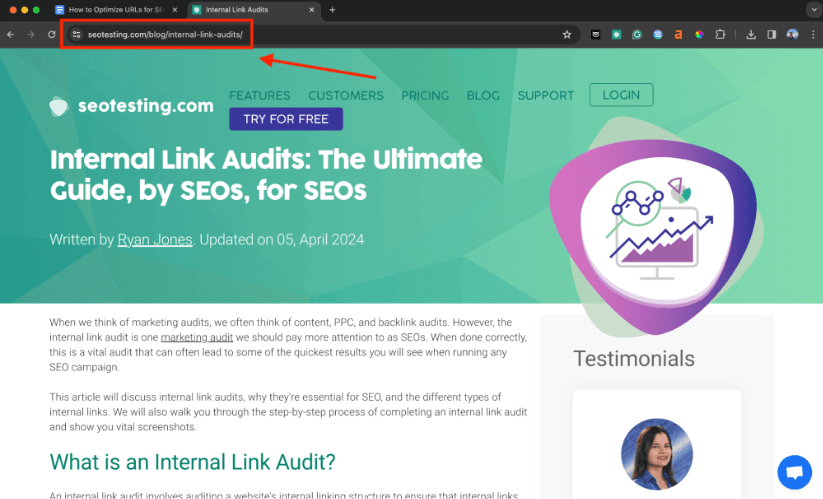
URLs allow browsers to find and display pages, videos, images, and other content, such as PDFs, by linking to the specific location on a server where that content is stored.
Beyond navigation, URLs also play a critical role in organizing a website’s content systematically, making it accessible and manageable for all users worldwide through internal links.
What is the Structure of a URL?
URLs, to work correctly, need to have certain elements within them. This applies to all URLs all over the web. Let’s take a look at the URL for this blog post:
The elements included within this URL include:
- The Protocol: https
- The Domain: seotesting.com
- The Subdirectory: blog
- The URL Slug: url-optimization
As an absolute minimum, a URL needs to include the protocol and the domain to function. Other elements are then added depending on the exact page you want to get to and where that page sits within the main structure of your website. However, browsers have evolved, and most of the time, you can type a URL without the protocol and still reach the desired URL.
For the example URL we used, you (and search engine bots) can denote that you are on the SEOTesting website within the blog section and you are looking at a blog post about URL optimization.
Why are URLs Important to SEO?
URLs are essential to SEO for several reasons. Better URLs create a better experience for both users who are actively using your site and bots from different search engines that are crawling it. URLs are also a small ranking factor within Google search, so paying close attention to them will improve your organic traffic in the long term.
Below, we explain why URLs are essential to your website’s SEO.
1. Optimized URLs Make for a Better User Experience
Creating user-friendly URLs is vital to ensuring that your website’s visitors have a great experience while they are on your site.
When your website’s URLs are clear, short, and descriptive, they give users a hint about what the page is about before they click through to look for themselves. This will build trust and make it easier for users to remember (and share) the URL.
A well-structured URL acts as a sign, quickly guiding users to their destination. This reduces bounce rates and encourages visitors to spend longer on your website, which is a positive signal to search engines.
2. URLs are a ‘Minor’ Ranking Factor
We’ve known for some time now that URLs are a small factor within search engine ranking algorithms. Search engines use URLs to understand what content is on a page. Keywords included in URLs help show how relevant that content is to the original search query, which will help the page rank higher.
It’s also worth mentioning that a clean and simple URL structure allows search engines to crawl a site easily, indirectly contributing to better search engine visibility, as your content can be discovered quicker.
3. Optimized URLs can Act as Links
When URLs are well-optimized and include relevant keywords, they will serve as the website address and anchor text when copied and pasted in other places across the web.
With a bit of optimization, you can turn a link from meaningless (other than doing the job it needs to do) to something with actual link value, thanks to keywords that will help support the content on your site.
Since the URLs you write and optimize describe the content on your pages, they reinforce the link’s context, making it more useful to both users and search engines.
4. Better URLs can Improve Crawl Efficiency
How you structure your URLs can significantly impact how effectively search engine crawlers can crawl and understand your website. URLs that follow a proper hierarchy and structure allow bots to navigate a site more quickly and efficiently, ensuring that more of your pages are indexed.
Avoiding overly complex URLs with numerous parameters will reduce the risk of crawl traps (where bots get stuck in an infinite loop of URLs).
Efficient crawling means better indexing. Better indexing will improve your site’s visibility in search.
5. Better Click-Through Rates
Remember, when writing your URLs, their clarity and relevance can directly impact whether a user clicks on them. URLs that match the search intent and provide a good idea of the page content will significantly improve click-through rates in search results.
High CTRs show that the content is relevant and valuable, which shows search engines that a page is a good result for a particular search query.
Best Practices for Writing & Optimizing URLs
Before we discuss how to find candidates for URL optimization and how to optimize your URLs, we need to discuss the best practices for writing and optimizing your website’s URLs.
Keep URLs Short and Sweet
When writing your URLs, remember to keep them short and sweet. Short URLs are not only easier for users to read and remember, but they also make it easier for those users to share across their network. Plus, they are less likely to be truncated on social media sites and within search results.
Keeping your URLs concise while fully explaining what they are about is challenging. However, doing this will strike the right balance between being functional and nice to look at, making them much more approachable for users and search engines alike.
Keep URLs Readable
Ensuring your website’s URLs are readable to humans and search engines is crucial. A URL should show precisely what the content on the page is about, making it understandable at a glance. You should avoid long strings of numbers, letters, and special characters that can confuse users and detract from the user experience. A well-crafted, readable URL enhances usability and SEO at the same time.
Use Relevant Keywords
Including relevant keywords in your URLs can significantly improve your search engine visibility. Keywords in URLs help search engines understand a page’s content, making it more likely to rank for those terms.
Remember to use keywords properly and ensure they accurately reflect the page’s content. Don’t keyword stuff, which can harm your site’s SEO.
Use Hyphens to Separate Words
Using hyphens (-) to separate words within your URLs is standard practice across the web. This makes them easier for users and search engines to read and understand. Avoid using underscores (_), spaces, or any other characters as separators because this can lead to issues with crawling and indexing.
Which URL slug looks better to you?
/blog/web-page/
/blog/web_page/
Naturally, the answer is option 1. Search engines think this way, too, so choosing URLs that are separated simply will make it easier for users and search engines to read and understand.
Avoid Useless Parameters and Dynamic URLs
You should always be wary of using parameters and dynamic URLs that complicate your website’s structure.
Static URLs are preferred over dynamic ones because they are more user-friendly for search engines to understand.
Don’t worry. We know that sometimes you must use dynamic URLs because of the site’s makeup. If they are unavoidable, ensure they are as clean and as simple as you can make them. This is especially true for ecommerce sites.
Write URLs in Lowercase
When crawling a website, have you encountered some URLs written in all lowercase, while some URLs include uppercase letters? It is advisable to ensure you write all of your URLs in lowercase to avoid issues with confusion and duplication.
Google treats uppercase and lowercase characters as different entities, which can lead to issues with URLs duplicating the pages. While canonical tags can resolve this, it’s best not to create the problem if possible.
Sticking to lowercase across all of your site’s URLs ensures that users and search engines find a unified version of your site’s URLs.
Limit the Number of Folders Used
Any website you encounter often includes folders to organize content in a hierarchy. It’s wise to limit the number of folders used in a URL to avoid overly complex URLs that are hard to read and, in some cases, may even dilute the site’s SEO efforts.
Choosing a simpler structure with fewer folders makes it easier for search engines to understand your website’s structure. It also improves the user experience by making URLs more memorable and straightforward.
How to Optimize a URL for Search
We will now take a deep dive into how actually to optimize the URLs across your website.
Find Any ‘Unoptimized’ URLs
Your first step is to find any URLs that could be classed as ‘unoptimized.’ You’ll start by running a full website crawl using a tool like ScreamingFrog or Sitebulb. We’ll use Screaming Frog for this article, but the steps are repeatable no matter what crawler you choose.
Run the crawl of your site. This will give you a list of all the URLs that your site includes. For additional detail, you can include your sitemap URL to ensure no URLs are missed during the crawl. The result should look something like this:
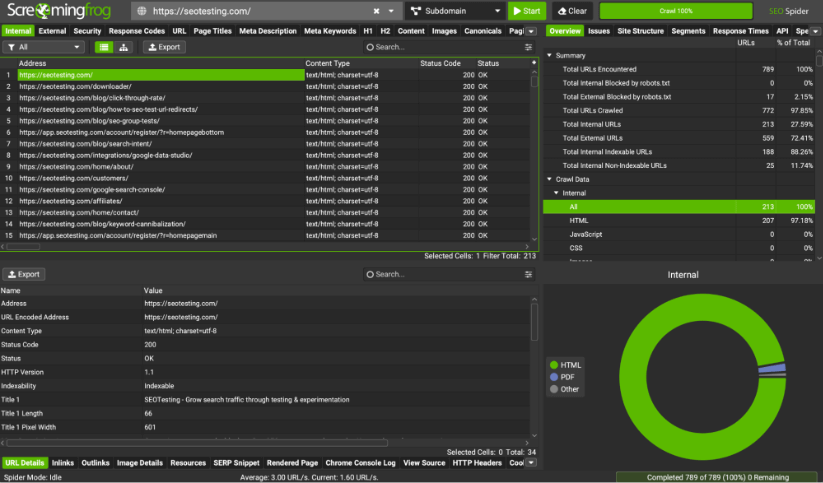
When using Screaming Frog, you can see a list of your URLs at the top left-hand side of your site crawl.
Your next step will be to find URLs that need to be optimized using the parameters we shared in the section earlier. Head through your crawl file and copy any URLs you need to optimize into a new spreadsheet to save a copy later.
Google Search Console also offers excellent insights into how Google views your website. It identifies URLs that are performing poorly and having indexing problems. Manually reviewing your site’s architecture helps spot URLs with unnecessary parameters or complex structures.
Essentially, what you are looking for are any URLs on your site that:
- Are too long.
- Include parameters that are not needed for the site to function.
- Do not include the page’s target keywords.
- Include uppercase characters.
Once you have found these, you can note them and work on optimizing them.
Re-write the URLs, Follow the Best Practices
Using the spreadsheet of unoptimized URLs you created earlier, your next step will be to write new URLs in that spreadsheet, adding additional columns to show each project stage.
You can use the example below:
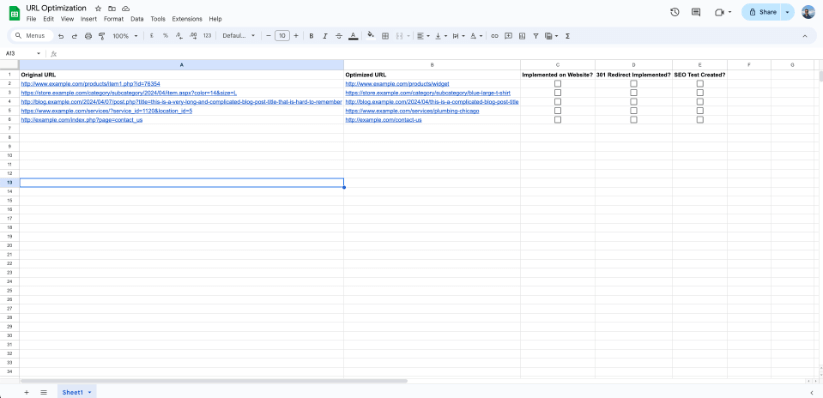
The above screenshot shows a good example of a spreadsheet you can replicate for your URL optimization projects. It shows the old URLs and the new URLs and includes different project stages:
- Has the URL change been implemented on your site?
- Has the URL change been ‘solidified’ with a 301 redirect?
- Have you set up an SEO test to track the results of the change?
This will allow you to track each stage of your project.
Want to save yourself time and use our spreadsheet template? Create a copy of it by following this link: https://docs.google.com/spreadsheets/d/1FWo_9_fa5ZAlp9RKs9sMWBunYiasNR2vjIpba8eo5HI/edit?usp=sharing
Implement a 301 Redirect from the Old URL to the New URL
Remember, SEO 101: if you change a URL on your website, you need to implement a 301 redirect to take users to the new page and show search engines that they should disregard the old URL and use the new URL.
Ensure this step is completed every time you change a URL on your website, whether for URL optimization purposes or not.
Set Up an SEO Test on the URL Change
Your final step is to ensure you set up proper SEO tests to measure the results of any URL changes/optimizations you make across your website.
Of course, you can do this using Google Search Console, manually exporting the data daily and plotting these changes in a graph. This is great and will offer great insights. But who has the time for this?
You can also set up a URL switch test within SEOTesting:
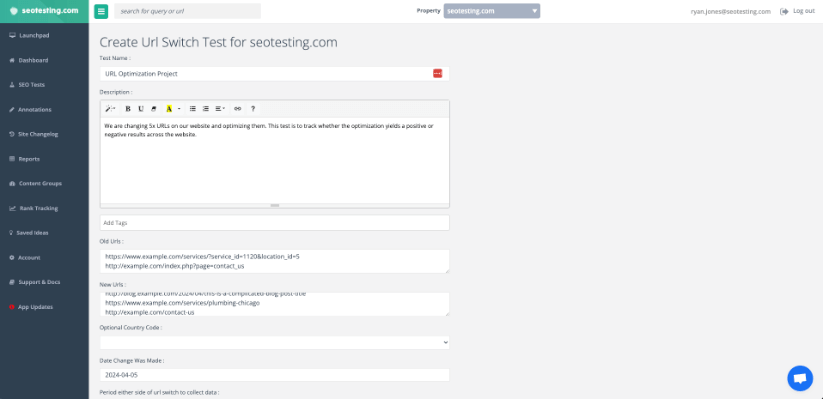
This will automatically measure and track the results of your optimization projects and plot them on a graph.

Testing URL Optimizations with URL Switch Tests
URL switch tests are a crucial aspect of proper SEO testing. They focus on assessing the impact of changing a page’s URL on search engine rankings and user engagement.
This process involves redirecting an existing URL to a new one and measuring its effect on different SEO metrics, such as page clicks, impressions, and click-through rates. URL switch tests are essential when optimizing URLs, moving to a new domain, or rebranding.
Setting up a URL switch test within SEOTesting is a simple process.
Within SEOTesting, select the site you wish to set up a test on and click SEO Tests in the left-hand navigation. Click the ‘Create a new SEO Test’ button, and on the following screen, click ‘Create URL Switch Test.’
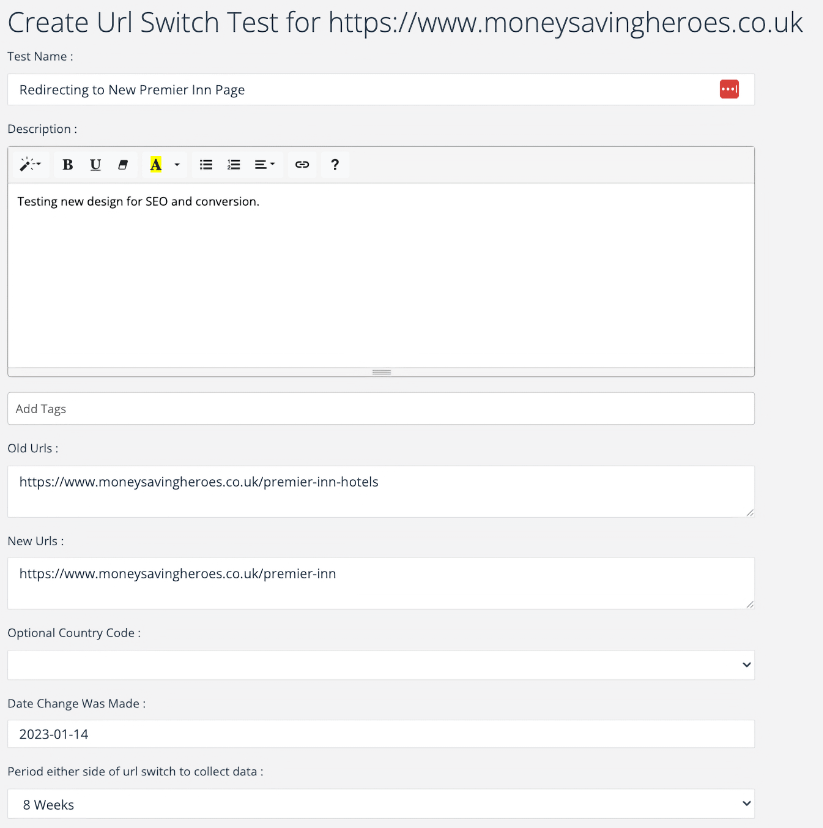
You need to give the test a meaningful name and description. The more information you provide about the changes you are testing, the more valuable the test and its results will be in 6 months or 12 months, as it will be easier to remember what was done to the page when you review it again.
In the ‘Old URLs’ text area, add the old URL you have redirected. In the ‘New URLs’ text area, add the URL to which the old URL has been redirected.
We have an optional country code to add, which will filter the data by a specific geographical country if you need to.
Ensure you add the date the change was made, and then set how long you want the test to run for. This is how long SEOTesting will measure data before the URL change went live and the date after that.
Here is an example of a URL switch test leading to a good result:

Wrapping Up
We’ve covered the fundamentals, from understanding what a URL is and its crucial role in your website’s architecture to the intricacies of optimizing these URLs to improve your organic traffic.
It’s clear that mastering URL optimization is not just about adhering to best practices; it’s about applying these practices into a cohesive strategy that enhances user experience, search engine crawling and, ultimately, helps improve your website’s visibility in search results.
From keeping URLs short and readable to incorporating relevant keywords and ensuring a clean hierarchy, each element is pivotal in making your website more accessible and appealing to users and search engines.
Use SEOTesting and start optimizing your URLs now to boost your organic traffic. Dive into our comprehensive tools to refine your SEO strategies with easy-to-follow tests and insightful analytics. Don’t miss out; begin with our free 14-day trial today and discover your website’s true potential.


